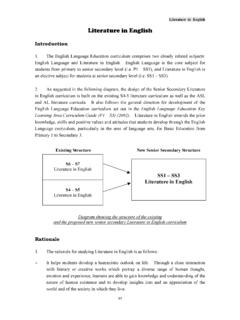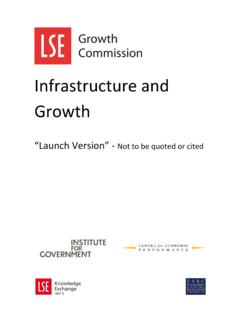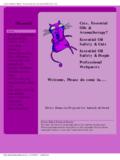Transcription of MEASLES AEROSOL VACCINE PROJECT - REPORT …
1 MEASLES AEROSOL VACCINE PROJECT - REPORT TO SAGE 1 MEASLES AEROSOL VACCINE PROJECT - REPORT TO SAGE GOAL OF THE MEASLES AEROSOL VACCINE PROJECT .. 1 WHY A MEASLES AEROSOL VACCINE ? .. 1 The potential to reduce the challenges link to injection safety and waste management .. 1 Positive lessons learned from polio campaigns suggest that a VACCINE that can be given by volunteers and be provided house to house can reach high coverage in low resource environments .. 2 IS THE MEASLES AEROSOL VACCINE SAFE? .. 3 IS THE MEASLES AEROSOL VACCINE EFFICACIOUS AND EFFECTIVE?
2 4 Evidence on immunogenicity of MEASLES AEROSOL VACCINE in infants below 10 months of age .. 4 Evidence on immunogenicity of MEASLES AEROSOL VACCINE in older infants and children .. 5 Evidence on immunogenicity of MEASLES AEROSOL VACCINE when administered as a second dose.. 7 Evidence of long-term persistence of MEASLES antibody titer after MEASLES AEROSOL VACCINE administration .. 7 Evidence of impact of MEASLES AEROSOL VACCINE when used during outbreaks .. 8 Evidence on the efficacy and effectiveness of MEASLES injectable VACCINE in infants and older children 8 Evidence on the cost and cost-effectiveness of a MEASLES AEROSOL VACCINE .
3 9 Assessment of the usability and acceptability of a MEASLES AEROSOL VACCINE .. 10 Evidence on immunogenicity of AEROSOL MEASLES Rubella and MEASLES Rubella Mumps containing vaccines .. 11 Potential additional research .. 11 REFERENCES .. 12 GOAL OF THE MEASLES AEROSOL VACCINE PROJECT The goal of the MEASLES AEROSOL PROJECT is to license at least one method ( VACCINE and delivery device) for respiratory delivery of currently licensed MEASLES vaccines. A MEASLES VACCINE that is effective, safe, easier to administer and with a comparable cost to subcutaneous administration.
4 WHY A MEASLES AEROSOL VACCINE ? The potential to reduce the challenges link to injection safety and waste management MEASLES immunization campaigns are effective elements of a comprehensive strategy for preventing MEASLES cases and deathsi. However, if immunizations are not properly administered or if immunization waste products are not safely managed, there is the potential to transmit bloodborne pathogens ( , human immunodeficiency virus and hepatitis B and hepatitis C). A safe injection can be defined as one that results in no harm to the recipient, the vaccinator, and the surrounding community.
5 Proper MEASLES AEROSOL VACCINE PROJECT - REPORT TO SAGE 2 equipment, such as the exclusive use of auto-disable syringes and safety boxes, is necessary, but these alone are not sufficient to ensure injection safety in immunization campaigns. Equally important are careful planning and managerial activities that include policy and strategy development, financing, budgeting, logistics, training, supervision, and monitoring. The key elements that must be in place to ensure injection safety in MEASLES immunization campaigns are outlined. According to the Safe Injection Global Network (SIGN) 2010 meeting reportii, the global burden of disease from unsafe medical injections has been estimated for the year 2008 by the World Health Organization from a probabilistic model.
6 In total unsafe medical injections led to 340,000 HIV infections, 15 million HBV infections, 1 million HCV infections, 3 million bacterial infections and 850,000 injection site abscesses in 2008. These infections accounted for 14% of HIV infections, 25% of HBV infections, 8% of HCV infections and 7% of infections with bacteraemia worldwide and accounted for 28 million disability adjusted life years, a metric of the years of life lost to death and disability from AIDS, acute hepatitis, liver cancer, end-stage liver disease and fatal sepsis. After adjustment for a change in methodology in calculating the number of HIV infections resulting from unsafe medical injections, these figures represent a reduction in the burden of disease from unsafe medical injections since the year 2000.
7 Positive lessons learned from polio campaigns suggest that a VACCINE that can be given by volunteers and be provided house to house can reach high coverage in low resource environments The use of the bifurcated needle was one of the key elements in the achievement of smallpox eradication goal, together with strong political support and the adequate implementation of appropriate strategies. Similarly, experiences with polio eradication suggest that vaccination by volunteers using a house to house strategy had resulted in effective outbreak control and interruption of wild poliovirus transmission.
8 Selected experiences over time are described below. In 1993, due to persistence of poliomyelitis cases in the Pacific Coast of Mexico and particularly in the state of Sinaloa, a house to house vaccination strategy named "Sinaloa Operation" was carried out in 100% of the territory of this stateiii. Simultaneously, teams of nurses carried out a population census of children less than five years old and pregnant women and vaccinated the children with Sabin trivalent VACCINE in undiscriminating form. In total, 301, 441 Sabin VACCINE doses were administered. As a result of this programme Sinaloa has not had any other polio case ever since.
9 In a 1993, during a mass immunization campaign in Egypt, the VACCINE coverage rate and per child vaccination costs were compared for house-to-house versus fixed-site oral poliovirus VACCINE (OPV) delivery iv. House-to-house delivery achieved 100% OPV coverage, compared to about 86% for fixed-site delivery (p ). The cost for house-to-house vaccination was 25% higher than for fixed-site vaccination in urban areas, while they were similar in rural areas. In urban areas, the cost per child vaccinated was similar for both fixed-site and house-to-house vaccinations ($ ).
10 In rural areas, it was higher for fixed-site delivery than for house-to-house delivery ($ vs. $ ). OPV wastage for both delivery approaches was the same (around 25%) in urban areas, while it was much higher for fixed-site vaccination than for house-to-house vaccination ( vs. ). These findings suggested that, in Egypt, house-to-house delivery was the most cost-effective strategy to achieve universal coverage and thus to eradicate polio. A cross-sectional study in Ethiopia aimed at collecting qualitative and quantitative data for the systematic and epidemiological assessment of the extent of a polio outbreak in three regions between December 2004 and February 2006 (24 confirmed wild poliovirus cases), its determinants, and the lessons learned as well as the implications for future control strategies to interrupt wild poliovirus transmissionv.















